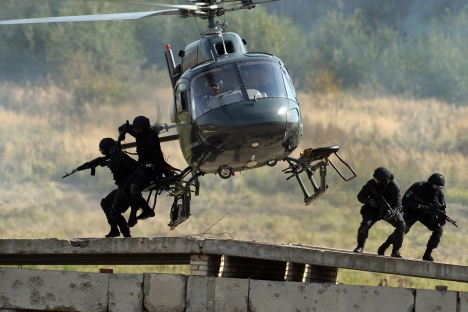
The Russian Air Forces have not participated in any drills of such scope for more than twenty years.Source: RIA Novosti
On May 27, several thousand Russian soldiers were woken at 5:00 in the morning by a surprise alarm. The Russian Ministry of Defense staged its biggest drills in more than twenty years to test the air forces.
The extraordinary combat readiness test involved 8,700 military personnel, 185 combat aircraft and 240 armored combat vehicles.
The aggressor squadrons launched an offensive at all altitudes and from all directions. They also employed jamming systems to impede target engagement by anti-aircraft radars.
The enemy’s air grouping initiating a large-scale missile and air strike launched several cruise missiles at the ground targets from the outer radar detection limit beyond the MiG-31 interception range.
The A-50’s radar system was able to detect the launches and the MiG-31 interceptors shot the cruise missiles down.
During the drills, the Western Military District’s bombers were redeployed to defend the outlying airfields against Su-24 and Su-34 attack aircraft bombing and carrying out missile strikes on ground targets, as well as to launch an offensive against the enemy aircraft and cruise missiles in the sky.
In the meantime, the Aerospace Defense Forces were warding off hostile sea-borne assaults.
The Russian Aerospace, Air and Anti-Missile Forces have not participated in any drills of such scope for more than twenty years.
Defense Minister Sergei Shoigu notified the Russian President of the outcome of the exercise on Friday. Vladimir Putin said the results were “satisfactory” and urged the military to modernize its control and telecommunications systems.
Given the absence of any public media reports on previous military exercises involving Moscow’s missile defense troops, which are now part of the Aerospace Forces, the Russian government seems to attach great importance to keeping these units ready to counter an unexpected nuclear strike.
The Russian military did not disclose who the potential enemy dealt with during the drills was but there are reasons to believe we may already know the answer.
Russia has repeatedly expressed concern over plans to create a European missile shield.
This issue was highlighted in a recent communication exchange between Vladimir Putin and Barack Obama, as well as at an international conference on European security held in Moscow the day before the drills.
After the event, Russia’s Defense Minister, Sergei Shoigu, paid a visit to the Voronezh-DM early warning radar station in service in the Kaliningrad Region.
Russia activates new early warning radar systems
In this light, the question of which state or organization is capable of challenging Russia’s missile defense today has quite an obvious answer: the United States and NATO, respectively. Apparently, they were the “potential enemies” during the drills.
No foreign military observers were invited to monitor the maneuvers – not only because the decision to carry out the drills came at such short notice but also because the Vienna Document only requires experts from abroad to be present at military exercises in which more than 9,000 people participate. This time, the drills were 300 people short.
At a Russian Defense Ministry general meeting held on May 30, it was confirmed that surprise tests assessing the combat readiness of various military districts, services and branches of the country’s armed forces will continue in the future.
All rights reserved by Rossiyskaya Gazeta.
Subscribe
to our newsletter!
Get the week's best stories straight to your inbox